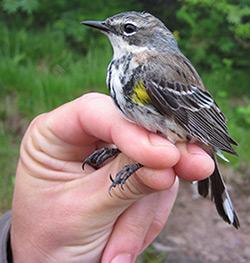DNA studies examine the past and future of the birds of New York's Catskills and Adirondacks.

Two papers have been published describing ornithological research by NYSM scientists. The papers are based on Ph.D. dissertation work conducted by Dr. Joel Ralston, former University at Albany graduate student, and NYSM Graduate Fellow under the supervision of NYSM Curator of Birds, Dr. Jeremy Kirchman.
The research examines patterns of genetic diversity in Blackpoll Warblers, small migratory birds that breed in the high-elevation forests of the Catskills and Adirondacks. The two ornithologists hiked up mountains to capture breeding warblers in nets, banded the birds and took tiny blood samples, and used the blood to obtain DNA sequences. Adding samples from other museum collections and blood sampled by other ornitholgists working outside New York, the team assembled data set of DNA sequences from over 350 individual birds. It is among the first comprehensive surveys of genetic variation in a bird species that breeds in the boreal forests of North America.
Analyses in the first paper (Continent-scale genetic structure in a boreal forest migrant, the Blackpoll Warbler (Setophaga striata). The Auk, July 2012, pp. 467-478) provide a detailed picture of how these migratory birds have responded to past climate changes. In particular, the study used DNA data to retrace the history of colonization following the retreat of glaciers from what is now the boreal forest biome beginning about 21,000 years ago. The birds apparently colonized the Adirondacks and Catskills when they expanded out of a "refugium" population that was located in the Southeastern United States during the Pleistocene.
The second study (Predicted range shifts in North American boreal forest birds and the effect of climate change on genetic diversity in Blackpoll Warblers (Setophaga striata), in press at Conservation Genetics) used the same tissue samples and additional genetic data (DNA sequences plus microsatellite genotypes) to examine the implications of ongoing climate warming for boreal forest birds that breed at high elevations at the southern periphery of the boreal forest biome that stretches from Alaska to the Canadian Maritime Provinces and Maine.
For this study the researchers first used current climate data and occurrence data (latitudes and longitudes from museum specimens) for 15 bird species that breed in the Adirondacks and Catskills to construct computer models of their current distributions. Then they used predicted climatic conditions, based on published carbon dioxide emissions scenarios, to estimate the breeding distributions of boreal birds the year 2080.
The results indicate that all of the fifteen species will shift their ranges north in the coming decades, and nearly all will become extirpated from their high-elevation habitats in New York, Vermont, and New Hampshire by 2080. The genetic data for Blackpoll Warblers suggest that, despite this extensive range shift, they will not loose much genetic variation and the species is not at risk of becoming extinct. However, other species may not be so lucky. Even so, it is disheartening to consider that within a single generation, we may see wholesale shifts in the Adirondack and Catskills ecosystems, and the day may come when one has to travel north of New York State to see breeding Blackpolls, Bicknell's Thrush, Spruce Grouse, Black-backed Woodpecker among many other prominent species.


